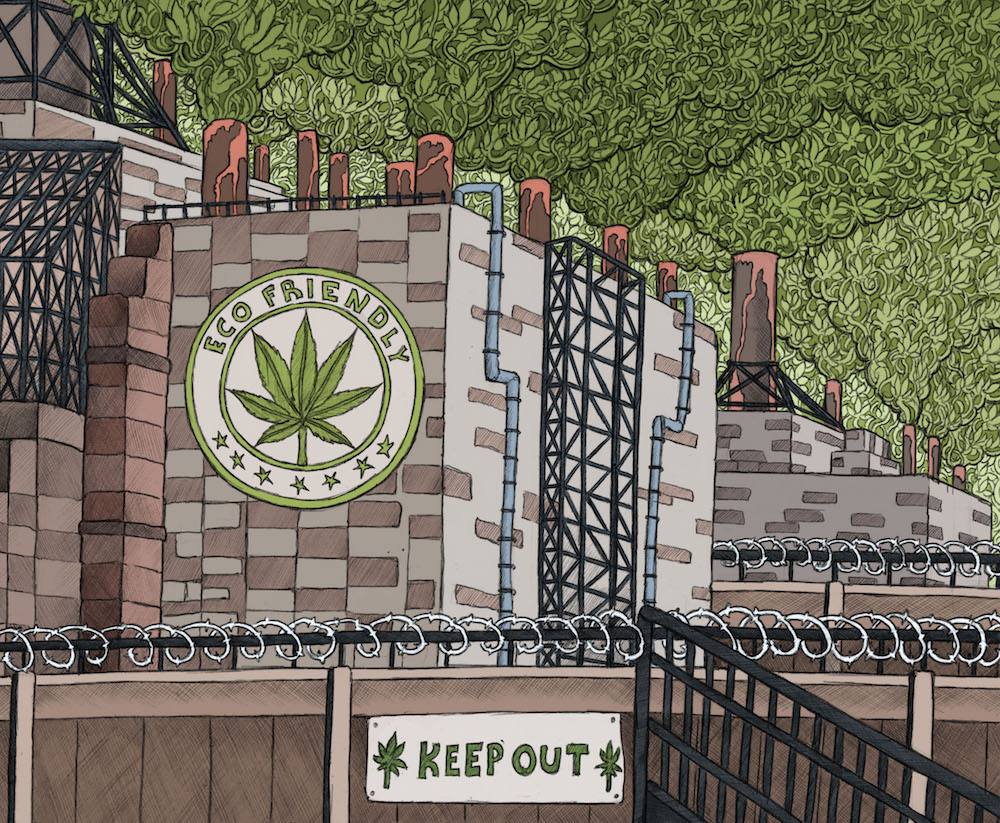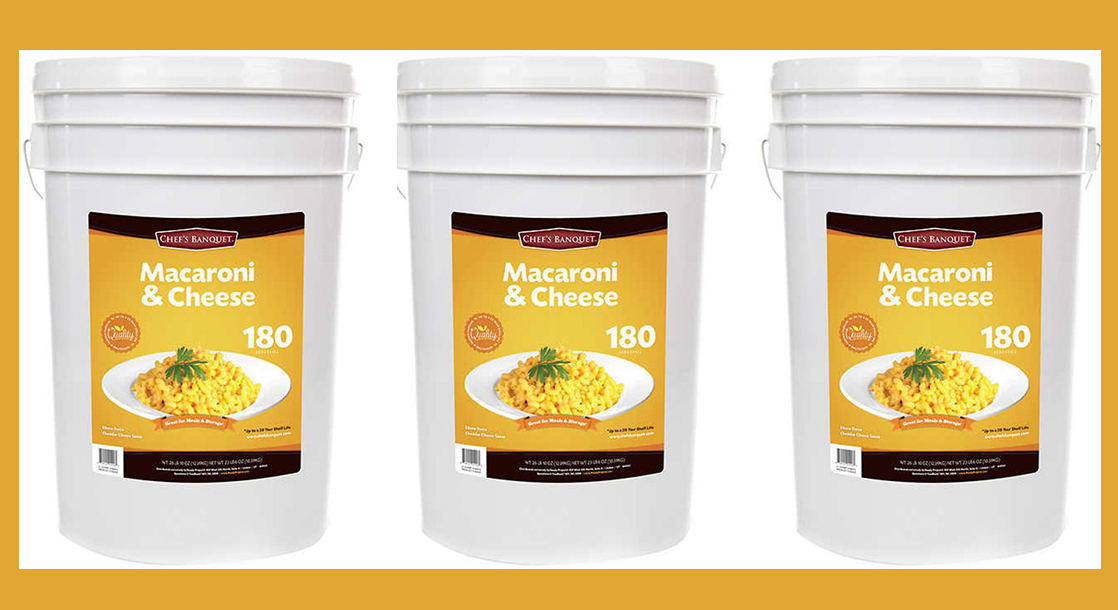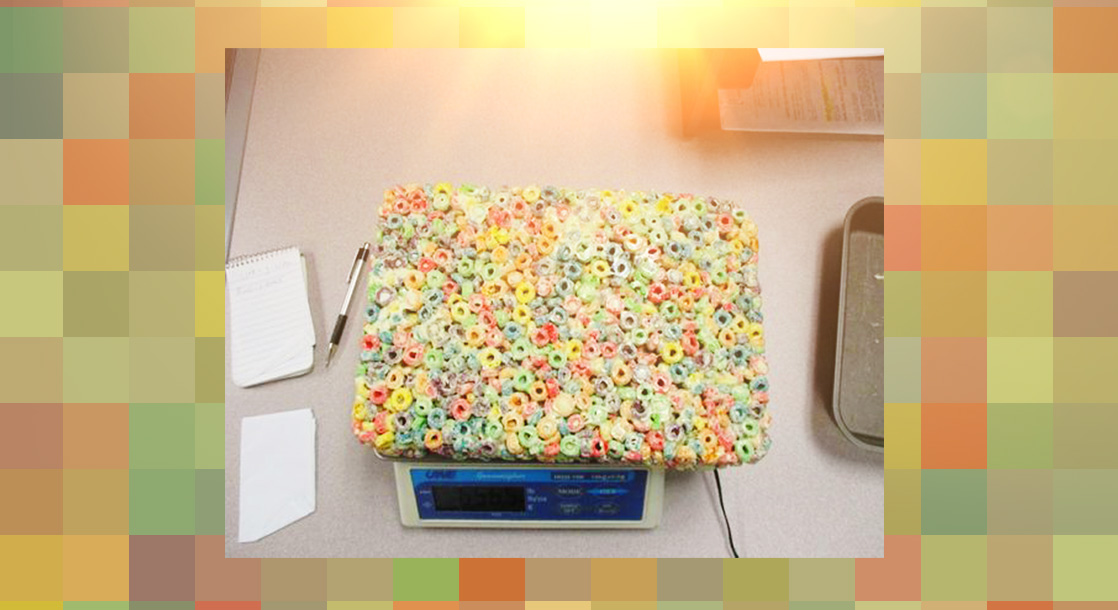Lead illustration by Allison Conway
It’s not easy being green. From solar-powered dome pipes to biodegradable filter tips, from bud grown without synthetic pesticides to edibles sold in compostable packaging, there are myriad cannabis (and cannabis-adjacent) products marketing themselves as eco-friendly. Real sustainability, however, is more rare, and consumer vigilance is required to spot the difference between mere greenwashing and eco-claims with integrity.
When it comes to deceptive marketing strategies, there’s a range of bullshit out there. Brands like Eleaf and Greentime and stores like Eco Vapez all incorporate a little green leaf into their logos while respectively producing and selling cheap plastic consumer products that are likely to end up in a landfill. To be clear, this green leaf is not the iconic marijuana symbol, but this need to disambiguate suggests how cannabis products are primed for eco-marketing. In addition to the little green leaf, the aforementioned brands bank on bright green packaging and vague terms like “green” and “eco” to stir up a positive association in the consumer, but they don’t go to lengths to allege their product’s environmental merit. Other companies, however, actually go out of their way to claim they’re eco-friendly with logic as twisted as a cross joint.
![]()
ABC Packaging Direct, for instance, makes plastic, child-resistant bags for medical marijuana, boasting their product is for “cannabrands making the decision to embrace… recyclable structural materials… and a positive impact on the environment.” That’s right, the manufacturer of a disposable plastic bag is suggesting their product has a positive impact on the environment. The website also has a text-heavy page devoted to “sustainable packaging information,” including a third-party logo for “the Sustainable Packaging Coalition” and lots of buzz words like “eco-conscious,” “biodegradable,” and “recyclable.”
The plastic bags ABC Packaging Direct manufactures are classified as #7 plastic and the web page suggests they can be easily broken down into regrind and used to make other plastic items, from park benches to dog toys. But with plastics, you have to take all recycling claims with a grain of salt. Although the technology exists to recycle certain types of polymer, many municipalities don’t have the facilities for this process, and even if you put the plastic waste in a blue bin, it frequently ends up at a landfill anyway. The Federal Trade Commission’s Green Guide recommends marketers should qualify recyclable claims with the admission that “recycling facilities for this product may not exist in your area.” What’s more, #7 plastic is the least likely of all plastic types to be recycled — according to Good Magazine, the rate is less than one percent — because it’s not even a category of one type of polymer, but rather the catch-all label for all the “other” polymers that don’t fit in categories one through six. Of course, this detail goes unmentioned in ABC Packaging Direct’s recycling spiel.
The web page devoted to evangelizing the sustainability merits of these plastic marijuana pouches also advertises that these bags “are much lighter than traditional containers, thus reducing the amount of fuel emissions required to transport products from point A to point B.” This is a classic greenwashing move, what the The Seven Sins of Greenwashing refers to as “the sin of lesser of two evils,” alleging “a claim that may be true within the product category, but that risks distracting the consumer from the greater environmental impacts of the category as a whole.”
Some cannabis companies use vague terms like 'green' and 'eco' to stir up a positive association in the consumer, but they don’t go to lengths to allege their product’s environmental merit. Others, however, actually go out of their way to claim they’re eco-friendly with logic as twisted as a cross joint.
Disposable packaging as a whole is not very environmentally-friendly, but unfortunately bringing your own reusable mason jar or tupperware from home and filling up on loose bud at the dispensary doesn’t jive with state regulations. Compliance with these local rules means proper labeling, tamper-proof packaging, and registry details for health and safety reasons, as well as to control taxation. Still, there are better alternatives than plastic bags. Sun Grown Packaging, for example, has developed a patented child-resistant “paperboard” package for the cannabis industry, which is made from recycled materials and can be recycled or composted as well. “Our thing is that the impact of this package is very gentle,” explains George Meding, director of product development at Oakland-based Sun Grown Packaging, in a phone conversation with MERRY JANE. “Consumers are very sensitive to this.”
The eco-friendly trend in the cannabis industry suggests that a lot of companies are banking on the idea that the marijuana customer is just as, if not more, eco-conscious than your average customer — that it’s a demographic with a love of both sorts of “green," and tapping into it could get you a third kind of “green.”

“In my experience, cannabis users are typically a bit more open-minded and less shut off to alternative ways of doing things,” notes Lucas Hildebrand, CEO and co-founder of Restalk — a company that produces paper from recycled cannabis plant byproduct — in an email exchange in MERRY JANE. Whatever the reason, the average cannabis user does seem willing to pay more for something eco-friendly. In Oregon, where Tyson Haworth’s So Fresh Farms sell their Clean Green Certified cannabis products, customers are willing to cough up a 10 to 20 percent premium for organic marijuana grown sustainably.
Like many eco-conscious marijuana farmers, Haworth turned to Clean Green Certified because the United States Department of Agriculture (USDA), which certifies produce like blueberries and avocados as “organic,” refuses to offer the same seal to marijuana because it’s federally classified as a Schedule 1 drug. Clean Green has emerged as one of the first independent third-party certification programs which backs up cannabis growers’ and sellers’ eco-claims with rigorous standards, not unlike the independent lab testing done by organizations such as SC Labs in California and The Werc Shop in Washington. Farmers like Haworth have to subject their product to soil sample testing for 300 different pesticides, and they need to have a carbon footprint reduction plan in place in order to receive Clean Green’s approval.
At Haworth’s farm in Canby, Oregon, they use predatory bugs, bacteria, and fungi to manage pests instead of synthetic chemicals, in addition to raised soil beds and no-till farming techniques which help preserve soil and prevent erosion. They’re also transitioning away from indoor growing, using light deprivation greenhouses and outdoor methods instead, which demand less artificial light and energy consumption. “Four weeks from now, it will be our last indoor cycle that we ever plan to run,” says Haworth. “You need to take advantage of the sun when it’s there to more efficiently grow cannabis.”
One advantage of indoor growing is the ability to control how many hours a day the cannabis plant is in light and in darkness. “It needs 12 hours of darkness to induce flowering. If you want to produce more than one crop per year then you have to control the dark cycle,” Haworth adds. Light deprivation greenhouses allow growers to take advantage of natural sunlight and to control dark cycles. Growing cannabis in northern Oregon, Haworth still needs to use artificial lights to achieve the necessary level of light intensity, especially in the winter months, but he saves a considerable amount of energy than if he was growing indoor all year round. Alternative growing methods is an urgent concern, as growing marijuana accounts for one percent of America’s total electricity consumption.
"The eco-friendly trend in the cannabis industry suggests that a lot of companies are banking on the idea consumers love both sorts of 'green,' and tapping into it could get you a third kind of 'green.'"
Haworth explained the Framework for Strategic Sustainability developed in the late ‘80s by Swedish cancer scientist Karl-Henrik Robèrt, outlining four system conditions for preserving life on Earth: not mining stuff out of the Earth’s crust at a faster rate than the planet can replenish it; not using synthetic man-made chemicals that nature doesn’t know how to degrade; not harvesting natural resources like forests and fish at a faster rate than nature can restock them; and to meet our needs as humans without compromising others’ abilities to meet their needs. “[The fourth system condition] really speaks to social equity,” notes Haworth. “Can the people who work on your farms or in your retail afford to live in their local environment? Can they afford to raise a family in their neighborhood?” He adds, “That’s one of the main reasons we cultivate in greenhouses.” When you grow outdoors and only harvest a crop once a year, you depend on temporary migrant labor. “The greenhouse has a big advantage. You can create a sense of community and have people working for you year round.”
In other words, there’s a moral component to marketing a product as eco-friendly. It would seem hypocritical to find out Green-Certified dish soap or Organic-Certified blueberries were produced by slave labor. As consumers, we should demand not only that there is integrity to a product’s eco-claims, but also that any product claiming sustainability is both kind to the Earth and to the humans producing it. Fortunately, there are frameworks emerging which combine environmentally-conscious cultivation and fair labor practices. Shortly over a month ago, the Organic Cannabis Association and the Ethical Cannabis Alliance merged into the Cannabis Certification Council, a non-government organization offering a national third-party certification program and seal. The Clean Green Certified program includes stipulations about worker payment and treatment, too. “With [the] lack of federal regulation, it is up to the cannabis industry to self-regulate,” asserts Amy Andrle, co-owner of the Denver-based farm and dispensary L’Eagle and a founding board member of the Cannabis Certification Council (CCC), in an email exchange with MERRY JANE.
While third-party certification programs are still numerous in other industries – there are at least 465 ecolabels in 199 countries according to the Ecolabel Index – standards for organic cultivation and appropriate eco-marketing are also outlined and enforced by federal government bureaus, respectively the USDA and the Federal Trade Commission (FTC). Without this federal oversight, Andrle is optimistic about self-regulation via programs like Clean Green Certified and the CCC, which strive for more rigorous standards than other industries. “Because we are new, and because of this long-standing anti-marijuana propaganda, we have more of a stigma to overcome,” she explains. “This gives us even more reason to set a better standard for ourselves.”

As the trend toward legalization continues, combined medical and recreational marijuana is the fastest growing industry in the US. By 2021, legal marijuana markets are expected to achieve upwards of $20 billion in revenue annually, according to a report by the ArcView Group. With this rapid growth, now is the time to make sure the green rush isn’t green washed. More marijuana could mean more fossil fuel-powered indoor grow lamps, more unrecovered wastewater, more toxic pesticide pollution, and more plastic packaging filling landfills. Or, alternatively, if regulatory frameworks and savvy consumers provide clear incentives for growers to adopt sustainable practices, it could mean a new industry leading the way toward a future of organic cultivation, waste reduction, and ethical labor practices. Cannabis entrepreneurs like Haworth of So Fresh Farms are taking steps toward this future. “For every gram of cannabis consumed,” he affirms, “we want to sequester carbon while creating careers for local Oregonians.”
Follow Whitney Mallett on Twitter and visit her website.
For more of Allison Conway's illustration work, check out her site here.











